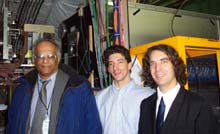|
MIPP Collaborators Celebrate End of Preparation, Start of Data Taking
The experiment will measure the identity, energy and angles of all particles emitted from the collisions of protons, pions and kaons with a wide variety of targets. "The main thrust of MIPP for high energy physics is to acquire high-statistics, high-quality data with a liquid-hydrogen target," says spokesperson Rajendran Raja. Scientists know little about such collisions whose properties fall within the realm of non-perturbative quantum chromodynamics. Raja believes that "MIPP data will help jump-start the study of this neglected field of high-energy physics." Physicists will also have data from MIPP to improve predictions for particle and nuclear physics experiments and to search for new phenomena such as pentaquark states and glueballs. The Main Injector Neutrino Oscillation Search, a Fermilab experiment, will use MIPP data to more accurately predict the spectrum of neutrinos that will reach the underground MINOS detector in Minnesota. The LLNL proton radiography program will use MIPP data from collisions of protons with various targets. Proton radiography is a type of three-dimensional "x-ray" process using beams of protons to make images of dense objects. MIPP data will provide a good knowledge of the protons interactions with the object's materials, essential for producing an accurate image. Besides data, the experiment will provide training for students and postdoctoral researchers. David Miller, a graduate student from Purdue University, believes that MIPP is "the best possible experiment at Fermilab for graduate students" due to its short time frame and the exposure to all aspects of a particle physics experiment.
The MIPP experiment recycles many pieces of donated and refurbished
equipment, including virtually all of the particle detectors from
previous experiments. Recycling reduced MIPP's cost from more than
thirty million to about two million dollars collaborators said.
Lawrence Berkeley National Laboratory donated the detector central to the experiment, a time projection
chamber. The Jolly Green Giant, a nickname for a large magnet in which
the time projection chamber sits, dates from the 1960's at Harvard
University and has served in many Fermilab experiments. In addition
to donating equipment, Fermilab, LLNL and the Department of Energy
contributed funding for MIPP.
|
| last modified 11/11/2003 email Fermilab |
FRLsDFx9eyfrPXgV
